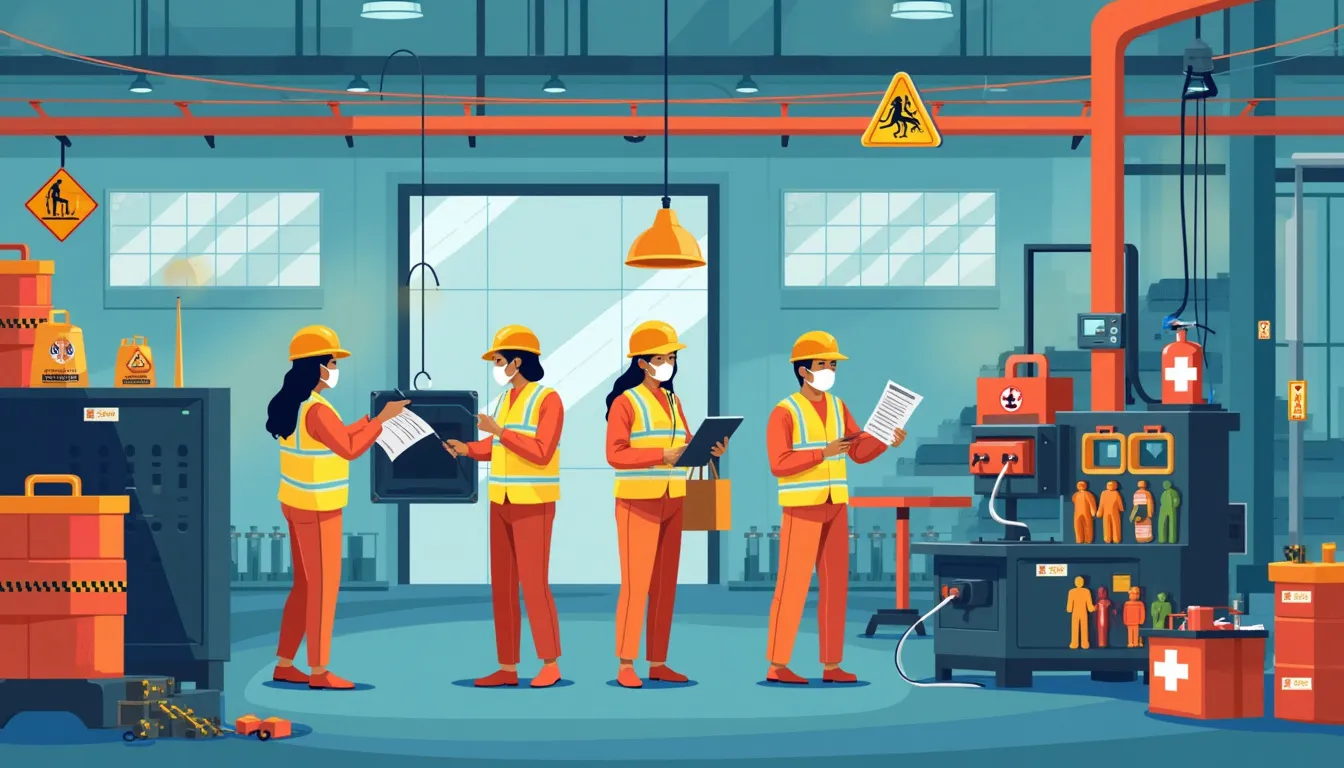In today’s fast-paced and ever-evolving business landscape, ensuring workplace security has become a paramount concern for organizations of all sizes. As the bedrock of a safe working environment, safety compliance audits serve an indispensable role. These audits are systematic evaluations designed to identify potential hazards, assess current safety protocols, and verify adherence to regulatory standards. By meticulously examining every facet of workplace safety, compliance audits create a robust framework that safeguards employees and enhances overall organizational stability.
The significance of safety compliance audits cannot be overstated. They bridge the critical gap between theoretical safety policies and the practical application of those policies within the workplace. By conducting regular audits, companies can preemptively tackle safety issues before they escalate into costly and potentially harmful incidents. Moreover, an effective audit process fosters a culture of continuous improvement, where employee confidence and morale are significantly bolstered. The financial implications are also noteworthy; through the reduction of liabilities and insurance costs, organizations can realize substantial savings while maintaining a safe and compliant work environment.
In essence, safety compliance audits are the linchpin of proactive workplace security strategy. For businesses aspiring to excel in safety standards, understanding and implementing comprehensive audits is not just an operational requirement—it’s a strategic imperative. By integrating regular safety compliance audits into their safety protocols, organizations can ensure a secure, compliant, and thriving workplace.
Introduction to Workplace Security and Safety Compliance Audits
Importance of Workplace Security
In today’s fast-paced business environment, ensuring workplace security is paramount. A secure workplace not only protects physical assets but also fosters a safe and productive environment for employees. Effective security measures reduce the likelihood of incidents that can disrupt operations, protecting the organization from potential financial and reputational damage. By prioritizing workplace security, businesses demonstrate their commitment to employee welfare and operational integrity, which can, in turn, enhance overall productivity and morale.
Definition and Purpose of Safety Compliance Audits
Safety compliance audits are systematic evaluations aimed at ensuring an organization’s adherence to established safety standards and regulations. These audits meticulously assess various aspects of workplace safety, identifying areas where improvements can be made. The primary purpose of safety compliance audits is to enforce regulatory compliance, minimize risks, and create a safe working environment. By conducting these audits regularly, businesses can proactively identify and mitigate potential hazards before they escalate into serious issues.
Connection Between Safety Compliance Audits and Overall Workplace Safety
The link between safety compliance audits and overall workplace safety is unequivocal. Safety compliance audits serve as a foundation for identifying gaps and inconsistencies in current safety practices. Through thorough assessments, audits provide invaluable insights into areas requiring immediate attention and improvement. This proactive approach helps prevent accidents and ensures that safety protocols are not only in place but also effectively implemented. By fostering a culture of continuous improvement, safety compliance audits contribute significantly to sustaining a safe and secure workplace.
The importance of routine safety compliance audits cannot be overstated. Their role in safeguarding employees and ensuring that businesses remain compliant with regulations makes them indispensable to organizational health and success. Regular audits instill a sense of accountability and vigilance, which, in turn, cultivates an environment where safety is a shared responsibility.
In summary, workplace security is essential for the seamless operation of any organization. Safety compliance audits are an invaluable tool in maintaining this security by ensuring adherence to safety regulations and highlighting areas for improvement. By integrating these audits into the workplace routine, businesses can create a robust and effective safety culture that benefits both employees and the organization as a whole.
Safetyology – Get The Book Today!

Key Components of Safety Compliance Audits
Identification of Potential Hazards
Identifying potential hazards is the cornerstone of any safety compliance audit. This involves meticulously examining every facet of the workplace, from physical structures and machinery to operational procedures and employee behaviors. Recognizing these hazards early on can prevent incidents that compromise both security and productivity. Utilize tools such as checklists, hazard maps, and incident reports to systematically uncover risks that may otherwise go unnoticed.
Evaluation of Current Safety Protocols
Once potential hazards are identified, the next critical step in safety compliance audits is the evaluation of existing safety protocols. Review the efficacy of measures like emergency response plans, personal protective equipment (PPE) usage, and machinery maintenance schedules. Consider feedback from employees who are often the first to experience the on-ground realities of these protocols. A comprehensive evaluation will highlight strengths, pinpoint weaknesses, and pave the way for refined and effective safety strategies.
Assessment of Regulatory Compliance
Staying abreast of regulatory requirements is non-negotiable in workplace safety. An effective safety compliance audit includes an in-depth assessment of how well your organization aligns with industry standards and governmental regulations. This may entail cross-referencing your safety practices with guidelines provided by bodies such as OSHA (Occupational Safety and Health Administration) or other relevant regulatory authorities. Taking this step ensures that your operations are legally compliant and shields your company from potential fines or legal actions.
Documentation and Reporting Processes
The significance of thorough documentation and clear reporting processes cannot be overstated in safety compliance audits. Detailed records serve as a historical archive of your ongoing commitment to workplace safety, providing invaluable insights during follow-up audits and continuous improvement initiatives. Documentation should encompass audit plans, identified hazards, compliance checklists, remedial actions, and timelines. Likewise, reporting should be transparent and accessible, keeping key stakeholders informed and accountable. Embracing digital tools can streamline documentation, making it easier to track progress and ensure nothing slips through the cracks.
Safetyology – Get The Book Today!

Benefits of Regular Safety Compliance Audits
1. Prevention of Workplace Accidents and Injuries
Safety compliance audits serve as a proactive measure to identify and address potential hazards before they cause harm. By regularly reviewing and refining safety protocols, businesses can significantly reduce the risk of workplace accidents and injuries. This not only protects employees but also ensures the smooth, uninterrupted operation of the company. The act of auditing itself often leads to a stronger safety culture, where awareness and prevention become part of the corporate ethos.
2. Enhanced Employee Confidence and Morale
Employees who feel safe at work are more likely to be productive and engaged. Regular safety compliance audits demonstrate a company’s commitment to their well-being, which in turn boosts confidence and morale. When employees trust that their employer prioritizes their safety, they are more inclined to reciprocate with loyalty and diligence. This positive workplace atmosphere is invaluable, fostering a collaborative and motivated workforce eager to contribute.
3. Financial Benefits Through Reduced Liabilities and Insurance Costs
The financial advantages of regular safety compliance audits extend beyond immediate cost savings. By systematically reducing workplace hazards and implementing stringent safety measures, businesses can lower their liability exposure. This proactive stance translates to reduced insurance premiums and fewer costs related to accident claims. Furthermore, a robust safety record can enhance a company’s reputation, attracting clients and partners who prefer doing business with a reliable and responsible entity.
4. Continuous Improvement in Safety Standards and Practices
One of the most significant benefits of routine safety compliance audits is the continuous improvement they promote within the organization. Audits are not a one-time fix; they are part of an ongoing process that evolves with the workplace. As new technologies and methods emerge, so too do opportunities to enhance safety protocols. Regular audits ensure that these updates are systematically integrated, keeping the organization at the forefront of safety standards. This commitment to continuous improvement not only ensures compliance but also fosters innovation and resilience in the face of changing regulatory landscapes.
Incorporating regular safety compliance audits into your business strategy is more than a regulatory necessity; it is a cornerstone of a thriving, secure, and forward-thinking workplace. The tangible and intangible benefits meld together to create an environment where safety and success go hand in hand.
Safetyology – Get The Book Today!

Implementing Effective Safety Compliance Audits in Your Workplace
Establishing a rigorous safety compliance audit protocol is more than a regulatory obligation; it’s a commitment to fostering a secure and thriving work environment. Here’s your roadmap to effectively implement and sustain safety audits that not only meet but exceed compliance standards.
Steps to Initiate and Maintain Effective Audits
The journey towards robust safety compliance audits begins with laying a solid foundation. First, define the scope of your audit by identifying high-risk areas and processes. Prioritize based on factors like past incidents, employee feedback, and industry-specific safety requirements.
Develop a standardized checklist that covers all relevant safety aspects. This ensures consistency and thoroughness across all audits. Moreover, assign designated audit teams accountable for periodic reviews and updates to the checklist, adapting it to evolving industry practices and emerging risks.
Training and Involvement of Employees
An informed and involved workforce is a cornerstone of successful safety compliance audits. Start with comprehensive training programs for employees at all levels. These programs should cover fundamental safety protocols, specific audit procedures, and the importance of compliance.
Encourage a culture of safety by actively involving employees in the audit process. Solicit their insights on potential hazards and feedback on current safety practices. Such engagement not only instills a sense of ownership but also unearths valuable, often overlooked, grassroots-level safety concerns.
Utilizing Technology and Tools for Efficient Audits
Leveraging technology can markedly enhance the efficiency and effectiveness of your safety compliance audits. Use specialized auditing software to streamline data collection, analysis, and reporting. These tools can generate real-time insights and trends, aiding in proactive risk management.
Additionally, consider implementing IoT (Internet of Things) devices and wearable technology to monitor compliance continuously. These technologies can provide instant alerts on deviations from safety protocols, ensuring timely corrective actions and minimizing potential risks.
Review and Follow-Up on Audit Findings
The true value of an audit lies in the actions taken post-evaluation. Thoroughly review audit findings and categorize them based on severity and urgency. Develop an actionable plan addressing each issue, detailing specific steps, responsible personnel, and deadlines.
Follow-up is crucial. Schedule subsequent audits to verify the implementation and efficacy of corrective measures. Regularly update all stakeholders on progress, reinforcing the organization’s commitment to safety. Such transparency not only ensures sustained compliance but also builds trust and confidence among employees.
By meticulously implementing these strategies, your organization can realize the full potential of safety compliance audits, creating a safer, more efficient, and more productive workplace.
In conclusion, the significance of ensuring workplace security through safety compliance audits cannot be overstated. As highlighted, these audits serve as critical tools in identifying potential hazards, evaluating existing safety measures, and ensuring adherence to regulatory standards. By incorporating regular safety compliance audits into your organizational routine, you create a safer, more secure environment that benefits everyone—most importantly, your employees.
Preventing workplace accidents not only safeguards your workforce but also enhances overall morale and trust within your organization. Furthermore, the financial advantages of reduced insurance costs and minimized liabilities offer tangible benefits that positively impact your bottom line. The continuous improvement in safety standards resulting from these audits fosters a culture of vigilance and responsibility.
Initiating effective safety compliance audits involves a strategic approach: starting with comprehensive planning, involving and training employees, leveraging advanced technological tools, and rigorously following up on audit findings. With these steps in place, safety compliance audits can become an integral part of your operational strategy.
Ultimately, the commitment to regular safety compliance audits exemplifies responsible leadership and dedication to a culture of safety and excellence. This not only protects your most valuable assets—your employees—but also paves the way for sustainable success and growth in an increasingly safety-conscious world.
Safetyology – Get The Book Today!
Support Us: Check out our recommended products on Amazon.

